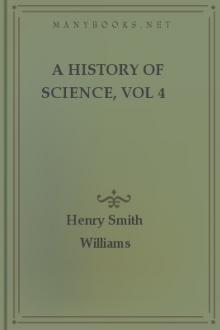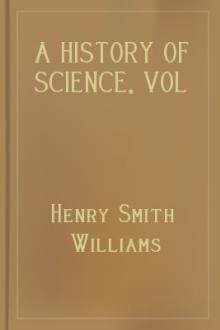A History of Science, vol 2, Henry Smith Williams [read this if txt] 📗

- Author: Henry Smith Williams
- Performer: -
Book online «A History of Science, vol 2, Henry Smith Williams [read this if txt] 📗». Author Henry Smith Williams
The influence on future medicine of Sydenham’s teachings was most pronounced, due mostly to his teaching of careful observation. To most physicians, however, he is now remembered chiefly for his introduction of the use of laudanum, still considered one of the most valuable remedies of modern pharmacopoeias. The German gives the honor of introducing this preparation to Paracelsus, but the English-speaking world will always believe that the credit should be given to Sydenham.
IX. PHILOSOPHER-SCIENTISTS AND NEW INSTITUTIONS OF LEARNING
We saw that in the old Greek days there was no sharp line of demarcation between the field of the philosopher and that of the scientist. In the Hellenistic epoch, however, knowledge became more specialized, and our recent chapters have shown us scientific investigators whose efforts were far enough removed from the intangibilities of the philosopher. It must not be overlooked, however, that even in the present epoch there were men whose intellectual efforts were primarily directed towards the subtleties of philosophy, yet who had also a penchant for strictly scientific imaginings, if not indeed for practical scientific experiments. At least three of these men were of sufficient importance in the history of the development of science to demand more than passing notice. These three are the Englishman Francis Bacon (1561-1626), the Frenchman Rene Descartes (1596-1650); and the German Gottfried Leibnitz (1646-1716). Bacon, as the earliest path-breaker, showed the way, theoretically at least, in which the sciences should be studied; Descartes, pursuing the methods pointed out by Bacon, carried the same line of abstract reason into practice as well; while Leibnitz, coming some years later, and having the advantage of the wisdom of his two great predecessors, was naturally influenced by both in his views of abstract scientific principles.
Bacon’s career as a statesman and his faults and misfortunes as a man do not concern us here. Our interest in him begins with his entrance into Trinity College, Cambridge, where he took up the study of all the sciences taught there at that time. During the three years he became more and more convinced that science was not being studied in a profitable manner, until at last, at the end of his college course, he made ready to renounce the old Aristotelian methods of study and advance his theory of inductive study. For although he was a great admirer of Aristotle’s work, he became convinced that his methods of approaching study were entirely wrong.
“The opinion of Aristotle,” he says, in his De Argumentum Scientiarum, “seemeth to me a negligent opinion, that of those things which exist by nature nothing can be changed by custom; using for example, that if a stone be thrown ten thousand times up it will not learn to ascend; and that by often seeing or hearing we do not learn to see or hear better. For though this principle be true in things wherein nature is peremptory (the reason whereof we cannot now stand to discuss), yet it is otherwise in things wherein nature admitteth a latitude. For he might see that a straight glove will come more easily on with use; and that a wand will by use bend otherwise than it grew; and that by use of the voice we speak louder and stronger; and that by use of enduring heat or cold we endure it the better, and the like; which latter sort have a nearer resemblance unto that subject of manners he handleth than those instances which he allegeth.”[1]
These were his opinions, formed while a young man in college, repeated at intervals through his maturer years, and reiterated and emphasized in his old age. Masses of facts were to be obtained by observing nature at first hand, and from such accumulations of facts deductions were to be made. In short, reasoning was to be from the specific to the general, and not vice versa.
It was by his teachings alone that Bacon thus contributed to the foundation of modern science; and, while he was constantly thinking and writing on scientific subjects, he contributed little in the way of actual discoveries. “I only sound the clarion,” he said, “but I enter not the battle.”
The case of Descartes, however, is different. He both sounded the clarion and entered into the fight. He himself freely acknowledges his debt to Bacon for his teachings of inductive methods of study, but modern criticism places his work on the same plane as that of the great Englishman. “If you lay hold of any characteristic product of modern ways of thinking,” says Huxley, “either in the region of philosophy or in that of science, you find the spirit of that thought, if not its form, has been present in the mind of the great Frenchman.”[2]
Descartes, the son of a noble family of France, was educated by Jesuit teachers. Like Bacon, he very early conceived the idea that the methods of teaching and studying science were wrong, but be pondered the matter well into middle life before putting into writing his ideas of philosophy and science. Then, in his Discourse Touching the Method of Using One’s Reason Rightly and of Seeking Scientific Truth, he pointed out the way of seeking after truth. His central idea in this was to emphasize the importance of DOUBT, and avoidance of accepting as truth anything that does not admit of absolute and unqualified proof. In reaching these conclusions he had before him the striking examples of scientific deductions by Galileo, and more recently the discovery of the circulation of the blood by Harvey. This last came as a revelation to scientists, reducing this seemingly occult process, as it did, to the field of mechanical phenomena.
The same mechanical laws that governed the heavenly bodies, as shown by Galileo, governed the action of the human heart, and, for aught any one knew, every part of the body, and even the mind itself.
Having once conceived this idea, Descartes began a series of dissections and experiments upon the lower animals, to find, if possible, further proof of this general law. To him the human body was simply a machine, a complicated mechanism, whose functions were controlled just as any other piece of machinery.
He compared the human body to complicated machinery run by water-falls and complicated pipes. “The nerves of the machine which I am describing,” he says, “may very well be compared to the pipes of these waterworks; its muscles and its tendons to the other various engines and springs which seem to move them; its animal spirits to the water which impels them, of which the heart is the fountain; while the cavities of the brain are the central office. Moreover, respiration and other such actions as are natural and usual in the body, and which depend on the course of the spirits, are like the movements of a clock, or a mill, which may be kept up by the ordinary flow of water.”[3]
In such passages as these Descartes anticipates the ideas of physiology of the present time. He believed that the functions are performed by the various organs of the bodies of animals and men as a mechanism, to which in man was added the soul. This soul he located in the pineal gland, a degenerate and presumably functionless little organ in the brain. For years Descartes’s idea of the function of this gland was held by many physiologists, and it was only the introduction of modern high-power microscopy that reduced this also to a mere mechanism, and showed that it is apparently the remains of a Cyclopean eye once common to man’s remote ancestors.
Descartes was the originator of a theory of the movements of the universe by a mechanical process—the Cartesian theory of vortices—which for several decades after its promulgation reigned supreme in science. It is the ingenuity of this theory, not the truth of its assertions, that still excites admiration, for it has long since been supplanted. It was certainly the best hitherto advanced—the best “that the observations of the age admitted,” according to D’Alembert.
According to this theory the infinite universe is full of matter, there being no such thing as a vacuum. Matter, as Descartes believed, is uniform in character throughout the entire universe, and since motion cannot take place in any part of a space completely filled, without simultaneous movement in all other parts, there are constant more or less circular movements, vortices, or whirlpools of particles, varying, of course, in size and velocity. As a result of this circular movement the particles of matter tend to become globular from contact with one another.
Two species of matter are thus formed, one larger and globular, which continue their circular motion with a constant tendency to fly from the centre of the axis of rotation, the other composed of the clippings resulting from the grinding process. These smaller “filings” from the main bodies, becoming smaller and smaller, gradually lose their velocity and accumulate in the centre of the vortex. This collection of the smaller matter in the centre of the vortex constitutes the sun or star, while the spherical particles propelled in straight lines from the centre towards the circumference of the vortex produce the phenomenon of light radiating from the central star. Thus this matter becomes the atmosphere revolving around the accumulation at the centre.
But the small particles being constantly worn away from the revolving spherical particles in the vortex, become entangled in their passage, and when they reach the edge of the inner strata of solar dust they settle upon it and form what we call sun-spots. These are constantly dissolved and reformed, until sometimes they form a crust round the central nucleus.
As the expansive force of the star diminishes in the course of time, it is encroached upon by neighboring vortices. If the part of the encroaching star be of a less velocity than the star which it has swept up, it will presently lose its hold, and the smaller star pass out of range, becoming a comet. But if the velocity of the vortex into which the incrusted star settles be equivalent to that of the surrounded vortex, it will hold it as a captive, still revolving and “wrapt in its own firmament.” Thus the several planets of our solar system have been captured and held by the sun-vortex, as have the moon and other satellites.
But although these new theories at first created great enthusiasm among all classes of philosophers and scientists, they soon came under the ban of the Church. While no actual harm came to Descartes himself, his writings were condemned by the Catholic and Protestant churches alike. The spirit of philosophical inquiry he had engendered, however, lived on, and is largely responsible for modern philosophy.
In many ways the life and works of Leibnitz remind us of Bacon rather than Descartes. His life was spent in filling high political positions, and his philosophical and scientific writings were by-paths of his fertile mind. He was a theoretical rather than a practical scientist, his contributions to





Comments (0)